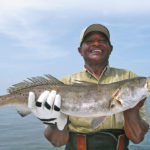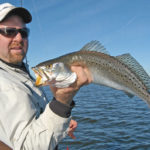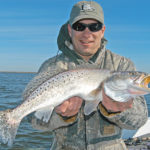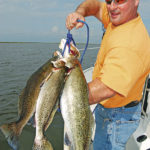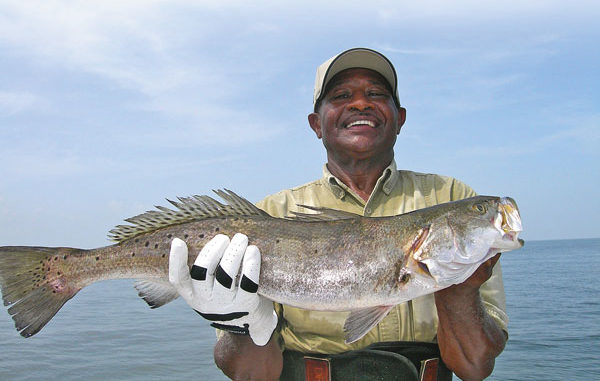
All over the marsh, there are spots holding speckled trout right now that you don’t know about, and neither does anybody else. Here’s how to find them.
“Come and listen to a story ‘bout a man named Jed,“Poor mountaineer, barely kept his family fed.
“And then one day, he was shootin’ at some food,
“And up through the ground come a bubblin’ crude.”
Poor Jed Clampett.
All those years he scratched and scrounged, unable to consistently put food on his family’s table.
He lived in a shack, drove a jalopy and ate whatever grew in the forest or scurried along its leaf-strewn floor.
All that time, Jed had millions of dollars under his land waiting patiently to be discovered.
During a trip to Delacroix last month, I felt just like Jed Clampett.
There’s a certain bayou that connects two lakes I fish all the time. The bayou’s not particularly deep, averaging maybe 10 feet at its deepest, and it’s quite indisctinct. It’s got a 90-degree bend near the mouth of one of the lakes, and from there, runs pretty well straight into the other lake.
Both of the lakes deliver specks under rattling corks every fall and winter. The two lakes have let me down in the past, but rarely. They’re usually good for at least 10 or 12 fish each, and frequently much more.
I’ve fished the bayou that connects them a few times, but only at the 90-degree bend. Like most anglers, I like to fish anamolies like points and bends, and I avoid boring straight-aways.
But last month, a buddy and I had struck out in the first lake. The water was filthy dirty, and that fact wasn’t being at all aided by a 20-m.p.h. wind howling in from the southeast.
That was our first stop of the day, and although the dirty water was a little unsettling, there were plenty of other spots to hit. I was confident we’d find something to salvage the day.
We motored into the boring bayou, and made the 90-degree turn, intending to head to the second lake. But up ahead, we saw a flock of about 20 birds having an all-you-can-eat shrimp feast unlike anything ever featured at Red Lobster.
The water in the bayou was just as dirty as that which we had found in the lake, but the birds didn’t seem to mind.
We eased up to the action, but with the relative narrowness of the bayou, it was impossible to stay far enough from the birds not to spook them. They stuck around to eat a few more of the shrimp that were leaping for their lives, and then flew away to less-pressured schools.
The trout, however, weren’t spooked in the least. My buddy and I each threw cork-suspended DOA shrimp, and hooked up immediately with every cast.
We kept our ice chest open, and it quickly became alive with wriggling trout, each occasionally thumping the side with rhythmic twitches of its tail.
But then the action began to slow. The slaps on the surface got less-frequent, and very few shrimp breeched the surface.
While my buddy reeled in his cork rig to make another cast, I switched over to a double rig that was tied on another rod.
I cast upcurrent, let the jigs fall to the bottom and began a herky-jerky, twitching retrieve.
About .3 seconds into it, I felt an unmistakable tap, and set the hook.
Whenever fishing on bottom, there are times a fish will try to rip the rod out of your hands. There are other times when you feel absolutely no hit whatsoever, but something just doesn’t feel right on the terminal end of your rig. And there are other times that fall somewhere in between.
Whatever type of strike you get, though, you never know if you’ve got the fish until you set the hook. Sometimes after a hook set, you feel nothing, look at your rod tip and it’s as straight as a field-tipped arrow.
Other times, you feel what you surmise is a hit, set the hook, feel resistance and look at your rod to see it bowed like a Saxon catapult.
That’s how my rod looked.
I cranked on the reel, and two keeper specks rose from the depths to thrash on the surface.
I hoisted them over the gunwale, unhooked them and threw their beautiful spotted bodies into the Igloo while my buddy gave his cork a few more pops.
I made another cast, and almost instantly set the hook on another double.
My buddy couldn’t reel in his cork fast enough.
On later casts, it became blatantly obvious why the fish were here: The bottom was carpeted with oysters. The shoreline gave way to a steep drop that felt rougher than 10-grit toilet paper.
It was essential to keep the baits hopping and moving; otherwise, they’d become hopelessly snagged on the oysters.
Either that, or snagged inside the lovely yellow mouths of keeper speckled trout.
Spots like this exist all over the marsh. From the surface, they look indistinct and unproductive, and are ignored by weekend anglers and fishing guides alike. They’re the fishing version of “fly-over country.”
But they hold untapped reserves of hungry trout that are waiting patiently to make you the piscatorial Jed Clampett. How do you find these areas? It’s not as difficult as you might think.
“Constant observation is the absolute key,” said Hopedale charter Capt. C.T. Williams. “Those are only two words, but they sum up a lot.”
Williams said that far too many anglers are concerned with trying to get to the next spot. They start the fishing day with an idea of the spots they want to fish, and they run through them almost like they’re checking items off a list at the grocery store.
“A lot of people hop in the boat and just ride to their spots,” he said. “When you’re running to a spot, you can’t be talking to your buddy or staring blankly straight ahead. You should always be looking.”
Looking for what, exactly?
“Clean water, moving water and bait,” he said. “Those are the big three. If you find those, you’ll find the fish.”
Birds are an obvious giveaway. From the moment he steps foot on his boat, Williams will be scanning the horizon looking for collections of sea birds.
And he doesn’t just look for the big, black-headed gulls. He also will search for the smaller terns, called liar birds locally.
“Some people say, ‘Oh, I never fish liar birds. They’re a waste of time,’” he said. “But I’ve caught lots of fish under liar birds. You might as well stop and fish them. A cast doesn’t cost you anything.”
A more subtle sign of fish activity is bait splashing or breeching the surface without any bird activity above it. Spotting such activity takes keen eyesight and more diligent attention.
“Check every shoreline, particularly at cuts and points,” Williams said, adding that anglers should scour likely looking areas with their eyes expecting to see activity. “Let’s face it: The fish are out there, and they’re feeding somewhere. I mean, this is Louisiana; we always have feeding fish. It’s just a matter of finding when and where they’re feeding.”
That changes, literally, by the day. On numerous occasions, Williams has put clients on fish on their fifth or eight or 10th stop of the day.
“The clients will always say, ‘Man, why didn’t you take us here first?’ Well, that’s because yesterday they were biting at the first spot I took you,” he said.
On every trip, Williams will also make a mental note of areas where he spots boats.
“Now, if somebody’s fishing an area, I’m not going to go in and fish right next to them,” he said. “But I may come back to that spot tomorrow, and see what’s there. The fishing grounds are free; nobody owns them.”
Fishing a lot of water is vital for discovering new spots.
“You’ve got to cover a lot of ground, whether you cover it by boat or by lure,” he said.
Covering a lot of ground by lure means expanding areas where you’ve had success in the past under similar conditions. Sometimes fish move, but not very far.
“If you’re fishing one of your hotspots, and you notice water falling out of a pond, go ahead and fish your area, but don’t leave before you cast to the water falling out of the pond,” Williams advised.
Covering ground by boat means heading to an ultimate destination, but always while scanning, looking for bait and clean, moving water.
The best anglers, Williams said, are those who have the self-discipline to stop often to fish new areas. Most stops may be unfruitful, but those that aren’t may produce fish for you for many years to come.
Take a shot. You never know what’s going to come a bubblin’ up.
Capt. C.T. Williams can be reached at (504) BIG-FISH.
